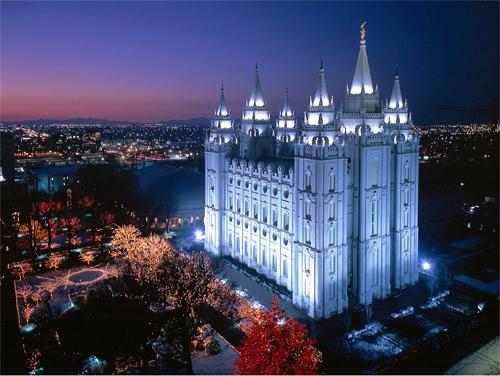 On July 24, 1847, the first body of Mormon pioneers, led by Brigham Young and the Quorum of the Twelve, reached the Salt Lake Valley. Four days later, Brigham Young marked the spot for the building of the next temple, which would serve as the center of their new city, Salt Lake City. As tens of thousands of Mormon pioneers migrated to Utah over the next few decades (nearly 80,000 by the 1870s), they continued to construct temples throughout the Rocky Mountains where they settled. The Salt Lake Temple remained a primary focus, however, even as the members worked to build up homes, cities, and the Utah territory in general. In 1855, a building called the Endowment House was erected on Temple Square, which is the block containing the Salt Lake Temple, to permit members to perform two important temple ceremonies, the endowment and celestial marriage, while the new temple was constructed. The Endowment House was torn down in the 1890s.
On July 24, 1847, the first body of Mormon pioneers, led by Brigham Young and the Quorum of the Twelve, reached the Salt Lake Valley. Four days later, Brigham Young marked the spot for the building of the next temple, which would serve as the center of their new city, Salt Lake City. As tens of thousands of Mormon pioneers migrated to Utah over the next few decades (nearly 80,000 by the 1870s), they continued to construct temples throughout the Rocky Mountains where they settled. The Salt Lake Temple remained a primary focus, however, even as the members worked to build up homes, cities, and the Utah territory in general. In 1855, a building called the Endowment House was erected on Temple Square, which is the block containing the Salt Lake Temple, to permit members to perform two important temple ceremonies, the endowment and celestial marriage, while the new temple was constructed. The Endowment House was torn down in the 1890s.
Meanwhile, the Mormons built other temples in places central to their widespread population, which soon covered all of what is now Utah, as well as parts of Nevada, Idaho, Wyoming, Colorado, and Arizona. Temples were constructed simultaneously in St. George, Manti, Salt Lake City, and Logan; all in Utah. In each case, Brigham Young, Prophet and President of the Mormon Church, selected the spot and oversaw the design. While these temples went forward with less persecution than had either of the first ones, there were numerous challenges, especially environmental challenges, as the Mormon pioneers sought to build their Zion in the desert. Large stones had to be hauled by oxen and wagon since no trains were available until 1869. In 1857, when Johnston’s Army invaded Utah because of false rumors about a rebellion, the completed foundations of the Salt Lake Temple, which had been laid on April 6, 1853, had to be buried for fear that the army might mistake a building with such thick stone foundations for a fortress. After the foundation was dug out, the stones were found to be cracked and had to be replaced.
In 1877, the first Mormon temple in the Rocky Mountains was completed in St. George. It was dedicated in a ceremony overseen by Brigham Young, which proved to be his only temple dedication in Utah. Brigham Young died in August of 1877. In January of 1877, the first Mormon temple ceremonies, endowments and sealings, were performed on behalf of the dead. Baptism for the dead had been practiced in the 1840s, but no Mormon temple had been complete long enough to permit the other Mormon temple ceremonies to be performed for the dead. It was in the St. George temple that the revelations regarding these ceremonies were received by Mormon prophet Wilford Woodruff. God revealed that the dead should also be sealed to their parents. In this temple, too, President Woodruff had a vision of the founding fathers of the United States and saw many prominent figures in world history, whose works had been inspired by God to improve mankind and to prepare the world for the Restoration of the full gospel of Jesus Christ.
In 1884, the Logan Temple was dedicated and, for the first time, the Mormon Church had two temples operating at once. In 1888, the Manti Temple was dedicated. In April of 1892, the exterior of the Salt Lake Temple was finished, and the temple was crowned with its now famous statue of the Angel Moroni, which has become a symbol of Mormonism. One year later, the interior was completed, and on April 6, 1893, exactly 40 years after it was begun, the Salt Lake Temple was dedicated by President Wilford Woodruff. The Salt Lake Temple is both the largest and most famous Mormon temple. It is also unique. It is the only temple with meeting rooms for the Quorum of the Twelve Apostles and President of the Mormon Church and also includes a spacious meeting hall used in sacred meetings. Most Mormon temples do not have such rooms.
Twitter •


 Watch a video about the restoration of the gospel on lds.org
Watch a video about the restoration of the gospel on lds.org
Great article. Thank you.